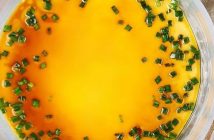
Last week, we wrote about different ways to have Chinese chives. As we look for more seasonal bites, we were surprised to find that even trees have something to offer. Xiangchun ya, the young leaves of the Chinese mahogany tree (香椿, xiangchun) have a strong herbal aroma, so as the tender sprouts of the tree’s seeds, xiangchun miao. Both of them are great additions to salads or egg dishes. Here are some ways to enjoy them.

Xiangchun miao salad with raw walnut 香椿苗拌核桃仁
Both xiangchun miao and walnuts are widely associated with spring. This light and fresh combination is best enjoyed raw and seasoned with just a bit of salt, pepper, and vegetable oil (see first image). Some restaurants mix xiangchun miao with strips of hard tofu (see above). Look for them at local Chinese restaurants like Jindingxuan and Meizhou Dongpo.

Fried xiangchun miao with egg and fresh lily 香椿苗鲜百合炒鸡蛋
The aroma of xiangchun miao is well-balanced with stir-fried egg. Adding fresh lily adds an interesting texture to the dish. Yu Restaurant at The Ritz-Carlton does a version for RMB 128.

Deep fried xiangchun ya 炸香椿芽
Heavily coated with batter and spices, fried xiangchun ya makes a delightful appetizer and snack for children. It’s so easy, you can try making this at home.

Xiangchun ya with soft tofu 香椿芽拌豆腐
This is a healthy and nutritious for both adult and children. Commonly available at most Chinese restaurants.

Egg omelet with xiangchun ya 香椿芽鸡蛋饼
Buy a handful of xiangchun ya in one of Beijing’s local markets, then make whip up some easy omelets for breakfast!
When produce is available year-round at Beijing’s farms and greenhouses, it’s easy to forget that each fruit and vegetable has its own sowing and harvesting cycle. Eating seasonally not only ensures the best-quality produce, it also helps maintain our body’s yin and yang balance, according to TCM. The Seasonal Eats series on beijingkids introduces foods best eaten this month.
Photos: mmmyoso and sweart (Flickr) and Emily Wu


